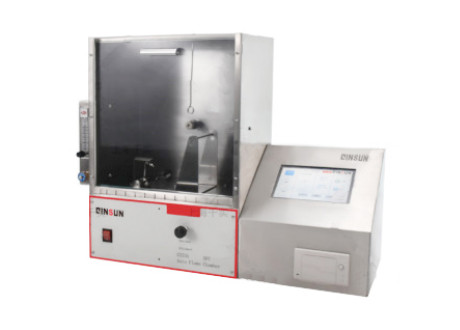How do I choose the right 45° flammability tester for my needs?
The 45° Flammability Tester is a test device for evaluating the combustion properties of materials. It is used in a wide range of applications in materials science, construction, automotive, and electronics to determine the burning characteristics of materials under specific conditions.

The core principle of this test apparatus is to tilt the material to be tested at an angle of 45° and then apply a heat source to ignite the material. By measuring the burning rate, flame propagation speed, burning time, smoke production and other parameters of the material, the flammability and overall fire behavior of the material can be evaluated.
The 45° Flammability Tester typically consists of the following major components:
1. a tilted sample holder, which holds the material to be tested at an angle of 45° to ensure that the burning behavior of the material in the tilted state can be observed.
2. Combustion Fuel Source: Provides the heat source required to ignite the material, commonly used combustion fuel sources include flames, sparks, high temperature ovens, etc. 3.
3. ignition device: used to ignite the material, usually a spark generator or flame igniter.
4. Data Acquisition System: Used to record and measure the parameters of the combustion process, including combustion rate, flame propagation speed, combustion time and so on.
5. Smoke extraction system: used to exhaust the smoke generated during the combustion process to ensure a safe and comfortable testing environment.
During the 45° flammability test, the material to be tested is first fixed on the sample holder, and then a suitable combustion fuel source and ignition device are set up. Once ignited, the test instrument records and measures the parameters of the combustion process to provide an objective assessment.
There are many factors to consider when choosing the right 45° Flammability Tester for your needs, and here are some suggestions to help you make an informed choice.
1. Determine the test requirements: First of all, you need to define your test requirements. Different industries and applications may have different testing requirements. Determine the type of material you need to test, the test standard and test parameters and other information, which will help you choose the right 45° Flammability Tester.
2. Consider the test standard: 45° Flammability Testers typically follow a specific test standard, such as ASTM D1230, ISO 9772, and others. Understand the test standards required for your industry or application and make sure the tester you select meets those standards.
3. Determine sample size and capacity: Different testers may have different sample size and capacity limitations. Make sure the tester you select can accommodate your samples and meet your testing needs.
4. Consider safety features: 45° flammability testing involves flame and combustion, so safety features are important. Choose a tester with good safeguards and safety features to ensure the safety of the operator and the laboratory.
5. Consider the ease of operation: the ease of operation of the test instrument is very important to improve work efficiency and reduce operational errors. Choose a tester with user-friendly interface, easy to operate and maintain, can improve the efficiency of the laboratory.
6. Consider data logging and analysis functions: modern testers usually have data logging and analysis functions, which can help you better manage and analyze test results. Choosing a tester with data logging and analysis features will improve the efficiency and accuracy of data processing.
7. Consider budget: Finally, you need to consider your budget constraints. Depending on your budget range, choose a cost-effective tester to ensure you get the best performance and quality.
In conclusion, choosing the right 45° Flammability Tester for your needs requires comprehensive consideration of test requirements, test standards, sample size and capacity, safety features, ease of operation, data logging and analysis capabilities, and budget. It is recommended that you conduct thorough market research and product comparisons before making your selection to ensure that you choose the most suitable tester.
2023-09-19 11:37
- Related News
The importance of battery internal resistance testing in the battery manufacturi
Application and structural principle of high and low temperature test chamber
Application of Small Coating Machine in Polyimide Slurry
Principles and selection methods of laboratory incubators
Evaluation of Moisture Absorption and Rapid Drying Performance of Textiles by Na
Liquid Moisture Management Tester
Paper ring compression strength tester standards
